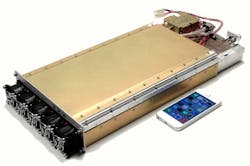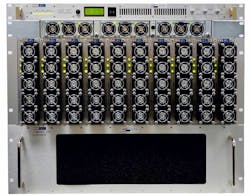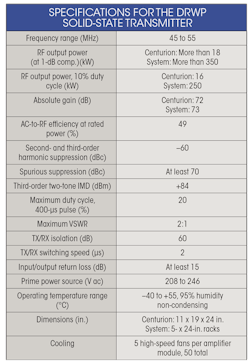This file type includes high resolution graphics and schematics when applicable.
Generating very high RF power levels within the high-frequency (HF) range has always been the exclusive domain of vacuum tubes. Solid-state devices such as silicon LDMOS or bipolar junction transistors lacked the efficiency, ruggedness, or output power to make them viable solutions.
However, times and technologies change—Delta-Sigma Inc. leveraged solid-state technology to design and build a transmitter for NASA’s Doppler Radar Wind Profiler (DRWP) at the Kennedy Space Center (Merritt Island, Fla.). The system produces more than 250-kW HF signal power with ac-to-RF efficiency of nearly 50% and ruggedness surpassing that of vacuum tubes.
Radar wind profilers operating at HF provide accurate data regarding wind strength and speed at various elevations above the Earth, making them extremely useful for assisting spaceflight, aviation, and meteorological applications. In spaceflight applications, for example, wind profiles are critical to the success of a mission. Even though a launch vehicle is quite strong, high winds can break it apart if loads are exceeded. Winds can also push it off course as it ascends, which can lead to a vehicle being ditched in the ocean. In either case, the result is a disaster, with people’s lives potentially at stake and launch costs typically escalating to hundreds of millions of dollars.
Many solid-state radar wind profilers operating at UHF and lower microwave frequencies are deployed throughout the world for applications other than spaceflight. Thus, they’re required to provide returns from relatively low altitudes. HF radar profilers must profile winds to 60,000 ft., which demands megawatts of effective radiated power to produce detectable return signals from weak reflections from tiny atmospheric particles. Consequently, the few HF wind profilers in existence are powered by vacuum tubes, a paradigm that NASA’s solid-state-powered system is dedicated to changing.
Once certified by NASA, the new DRWP, which replaces a tube-based system built in the early 1990s, will be the only solid-state-powered HF wind profiler in the U.S. It will be able to deliver results every five minutes to altitudes of 10 miles above a launch site in increments of 150 m.
Beyond Balloons
Although they might seem archaic, weather balloons (jimspheres) continue to be the sole determinant of wind conditions for spaceflight applications because previous radar profilers used decades-old technology. It goes to say, then, that NASA never considered those radar profilers to be reliable enough to replace jimsphere-generated measurements. Sensors on jimspheres are very precise and provide very accurate data, but jimspheres have significant disadvantages when compared to a radar profiler.
For example, multiple jimspheres must be launched at various times before each launch and require a crew to maintain and operate them, which means high operating costs. Once airborne, they typically drift as much as 60 miles away, where conditions may differ from those at the launch site. Conversely, a radar profiler is stationary and remains near the launch site.
In addition, jimspheres provide updated information only once per hour, making it unlikely that the latest data will be available at launch time. In contrast, the DRWP provides updated information every five minutes. Finally, because jimspheres are continuously ascending, it’s impossible for them to repeatedly provide data at 150-m increments of altitude like the profiler.
Inside the DRWP Transmitter
The transmitter developed by Delta-Sigma feeds an electronically steered array of three-element Yagi antennas covering several acres of area (Fig. 1). The beam created by the array is sent straight up or at multiple angles, and its signals are reflected from particles in the atmosphere. Since signal returns from tiny atmospheric particles are quite faint compared to those from an aircraft or other solid structure, the system employs an extremely sensitive, low-noise receiver. The radar system processes the returns using custom software, and results are displayed at a control center for analysis.
The DRWP’s transmitter is a modular system. At its core are 10 1.8-kW Delta-Sigma Valiant amplifiers (Fig. 2) that are mounted together in a rack. When combined, they form a Centurion amplifier subsystem (Fig. 3). The 20 Centurion amplifiers in the transmitter each produce 16-kW power and are accompanied by a logic unit, three-phase power supply, 10-way power combiner, filter, patented high-speed transmit/receive (T/R) switches, and other components.
The DRWP transmitter operates in Class AB bias conditions and produces 250-kW output. It’s conservatively rated to meet NASA’s requirements for redundancy and desired RF output power. However, the transmitter has demonstrated the ability to reliably generate 350 kW or more output power in the same configuration. While in the DRWP, it transmits a pulse-modulated signal, but the system can deliver the same output power in continuous-wave (CW) mode with a modified power supply.
The system employs a total of 400 model MRFE6V61K25 LDMOS RF power transistors from Freescale Semiconductor. They were selected for their ruggedness and reliability, even when simultaneously exposed to large impedance mismatches and 3-dB overdrive conditions. Detailed specifications are shown in the table.
To ensure the transistors would meet the system’s reliability requirements, Delta-Sigma performed three months of testing under pulsed and CW conditions, and subjected the devices to infrared thermal imaging to detect hotspots. They were also subjected to operating voltages that were higher and lower than the manufacturer’s rated levels, unterminated outputs, and other out-of-specification conditions. No failures were experienced during development or production, regardless of operating conditions.
System design required tight control of variations in gain, phase, and impedance among the hundreds of devices. This was accomplished using advanced materials and proprietary design techniques, which made it possible to attain optimum performance within the overall size constraints imposed by the equipment shelter.
Each Valiant amplifier module, measuring 2.25 × 8.50 × 18.00 in., consists of one predriver device, one driver device, and two final amplifiers. Every final amplifier stage employs two MRFE6V61K25 transistors capable of 1-kW CW output power that, when combined, produce 1.8 kW. The Valiant amplifier modules each have five fans. An integrated microprocessor helps monitor and control amplifier temperature, fan speed, dc voltage, and the status of the transmit/receive gate. Testing has shown that failure of one fan raises module temperature by only about 5°C.
This file type includes high resolution graphics and schematics when applicable.
Key System Specs
This file type includes high resolution graphics and schematics when applicable.
Since the DRWP’s receiver is extremely sensitive, it was essential that the transmitter be designed to prevent current from flowing through the transistors when in receive mode (gating). No ringing is present when the amplifiers are gated on and off, and there’s no effect on pulse shaping. The gating circuitry has rise and fall times of 30 ns, a transmit and receive switching speed of 3 μs, 60-dB isolation between the antenna and receive ports, and 0.3-dB insertion loss. The switch operates from a single +5-V dc supply, eliminating the possibility of interference to the receiver from voltage spikes that could occur with higher voltages.
The system features hot-failover capability—if a module fails, power is somewhat reduced and the load is spread throughout the other modules. All Valiant modules and power supplies can be hot-swapped while the system is in operation. The system is also designed to operate with one-third of its hot-swappable power-supply modules removed.
The DRWP has been in test operation at the launch facility since December 2014, and was used with the test launch of the Orion Multi-Purpose Crew Vehicle, a Space-X rocket launch, and several other missions. NASA will repeatedly test the DRWP until later this year, at which time it should be certified as a primary determinant of “go/no-go” launch decisions. When this occurs, it will be the only solid-state radar wind profiler in the U.S. with this distinction.
Ernesto G.F. Starri, President
Delta-Sigma Inc., 6690 Doolittle Ave., Riverside, CA 92503; (951) 343-4005
This file type includes high resolution graphics and schematics when applicable.





